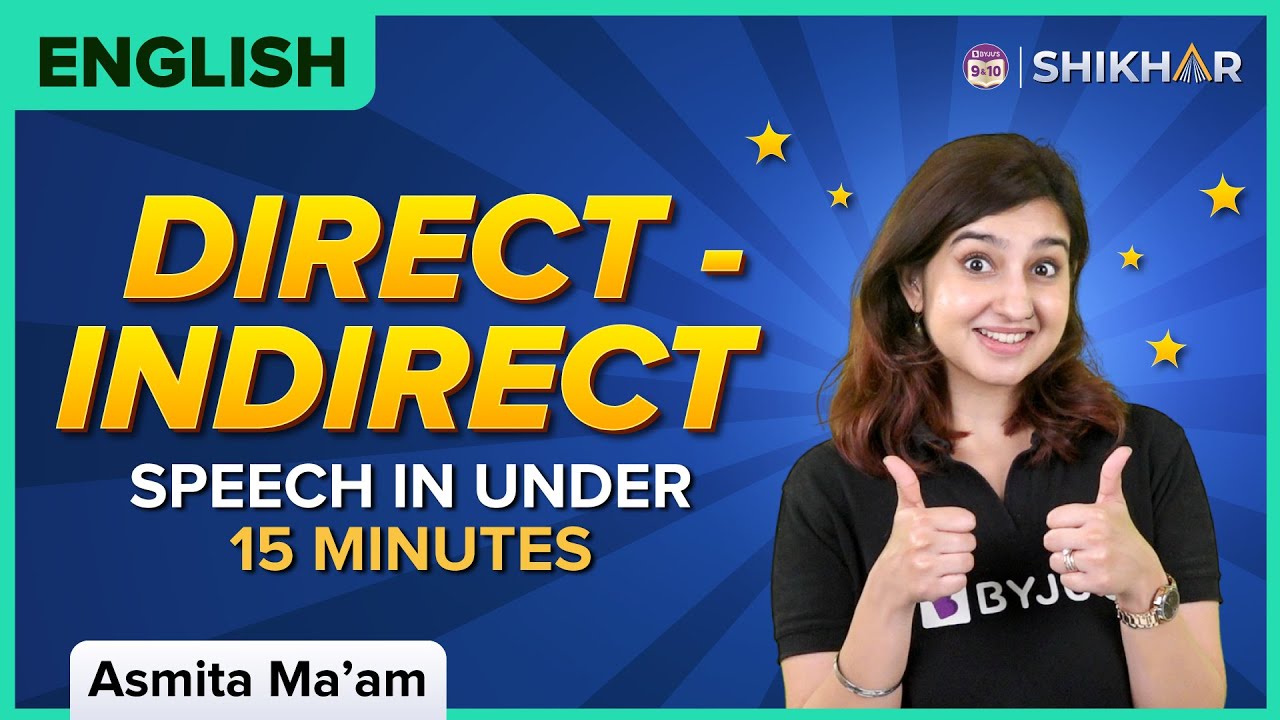Direct- Indirect Speech; Video Pembelajaran B.Inggris SMA
Summary
TLDRThis video tutorial explains the concept of direct and indirect speech, covering key aspects such as types of sentences (declarative, interrogative, and imperative) and the changes involved in transforming direct speech into indirect speech. The speaker highlights essential modifications in pronouns, tenses, possessive adjectives, and time expressions. Examples are provided for each sentence type, showcasing how to adjust verbs and phrases to fit indirect speech. The video also includes exercises for viewers to practice, ensuring a thorough understanding of the topic, with clear, accessible explanations suitable for learners.
Takeaways
- 😀 Direct speech quotes someone's exact words, while indirect speech paraphrases them without quotation marks.
- 😀 In indirect speech, pronouns change: 'I' becomes 'he/she', 'we' becomes 'they', and possessive pronouns adjust accordingly.
- 😀 Tense changes are crucial when converting direct speech to indirect speech, e.g., present simple changes to past simple.
- 😀 Time expressions in direct speech must also change in indirect speech, such as 'today' becoming 'that day'.
- 😀 There are three main types of indirect speech: declarative statements, yes/no questions, and wh-questions.
- 😀 Declarative statements in indirect speech often start with 'that', such as: 'He said that he was going to the market.'
- 😀 For yes/no questions, the word 'whether' is used to introduce indirect speech, like: 'She asked whether I had finished my homework.'
- 😀 Wh-questions in indirect speech maintain the question word (when, why, where, etc.) before the subject, like: 'He asked why she was crying.'
- 😀 Imperative sentences (commands or requests) are introduced with 'to + verb', such as: 'He asked me to open the window.'
- 😀 In negative imperative sentences, 'don't' changes to 'not to', as in: 'He told her not to worry about it.'
Q & A
What is the main topic of the tutorial?
-The main topic of the tutorial is about direct and indirect speech, explaining their definitions, types, and how to transform direct speech into indirect speech.
What is the key difference between direct and indirect speech?
-The key difference is that direct speech quotes the exact words of the speaker, while indirect speech reports what was said without using quotation marks, and typically involves changes in pronouns, tenses, and word structure.
How can direct speech be converted into indirect speech?
-Direct speech can be converted into indirect speech by removing quotation marks, adjusting the capitalization, adding reporting words like 'that' or 'whether,' and modifying pronouns, tenses, and time references.
What are the three types of indirect speech mentioned?
-The three types of indirect speech are: declarative statements, interrogative questions (both yes-no and wh-questions), and imperative statements (commands or requests).
What happens to pronouns when changing from direct to indirect speech?
-Pronouns change based on the perspective of the speaker. For example, 'I' becomes 'he' or 'she,' 'my' becomes 'his' or 'her,' and 'we' becomes 'they.'
How do time and place references change in indirect speech?
-Time references such as 'today' change to 'that day,' 'tomorrow' becomes 'the next day,' and 'yesterday' becomes 'the previous day.' Place references like 'here' change to 'there.'
How do tenses change when converting direct speech into indirect speech?
-Tenses change as follows: present simple becomes past simple, present continuous becomes past continuous, present perfect becomes past perfect, and so on. For future tenses, they change to the corresponding past future form.
Can you give an example of a direct to indirect speech transformation involving a statement?
-Sure! Direct speech: 'I will return your bicycle here as soon as I come home today.' Indirect speech: 'He said that he would return my bicycle there as soon as he came home that day.'
What is the change in a yes-no question when converted to indirect speech?
-In a yes-no question, the conjunction 'if' or 'whether' is used in indirect speech. For example, 'Have you finished your homework?' becomes 'He wanted to know whether I had finished my homework.'
How do imperative sentences change in indirect speech?
-In indirect speech, positive imperative sentences are reported using 'to' + verb. For example, 'Wake up now' becomes 'He told me to wake up.' Negative imperatives use 'not to' (e.g., 'Don't worry' becomes 'He told her not to worry').
Outlines

This section is available to paid users only. Please upgrade to access this part.
Upgrade NowMindmap

This section is available to paid users only. Please upgrade to access this part.
Upgrade NowKeywords

This section is available to paid users only. Please upgrade to access this part.
Upgrade NowHighlights

This section is available to paid users only. Please upgrade to access this part.
Upgrade NowTranscripts

This section is available to paid users only. Please upgrade to access this part.
Upgrade NowBrowse More Related Video

Jenis Kalimat dalam Bahasa Indonesia

BELAJAR DIRECT AND INDIRECT SPEECH (REPORTED SPEECH)

Jenis-jenis Kalimat || Materi 04

Full Concept of Narration, Direct and Indirect Speech, English Grammar Rules by Kanchan Keshari

BAHASA INGGRIS SMA - Reported Speech (Indirect & Direct Speech) | GIA Academy

Direct - Indirect (Reported) Speech in Under 15 Minutes | Class 9 and 10 | English | BYJU'S
5.0 / 5 (0 votes)